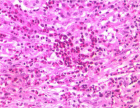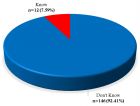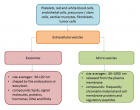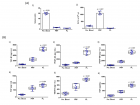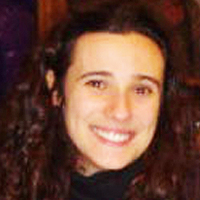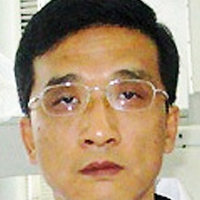Abstract
Review Article
Facial-onset sensory-motor neuronopathy, a rare variant of Huntington’s disease or chance association?
William Camu*, Raul Juntas-Morales, Elisa De La Cruz, Florence Esselin, Nicolas Pageot and Guillaume Taieb
Published: 15 July, 2021 | Volume 5 - Issue 2 | Pages: 069-071
Objectives: To describe a patient with facial-onset sensory-motor neuronopathy (FOSMN) that later developed Huntington’s disease (HD).
Case report: A 62-year-old woman complained of progressive dysphagia 8 years before referral. At initial evaluation, there was excessive salivation, dysphagia, and sensory-motor trigeminal impairment. Denervation was noted on the upper limbs and the tongue. Blink reflexes were abolished. Genetic study of amyotrophic lateral sclerosis (ALS)-related genes was normal. She was diagnosed with FOSMN syndrome. Her clinical state progressively worsened with corneal anesthesia, severe denutrition, right arm and axial weakness. Seven years after referral, she was unable walk and developed generalized chorea. Abnormal huntingtin gene repeat expansion confirmed the diagnosis of HD. She died 16 years after onset of dysphagia.
Conclusion: Cases with both HD and ALS have already been reported but not FOSMN and HD, to our knowledge. Some FOSMN cases have been linked to ALS-related gene mutations and HD phenocopies have been associated with C9ORF72 repeat expansions. Recently, huntingtin repeat expansions were described in the ALS population. Although a chance association cannot be excluded, data from the literature are in favor of a pathogenic relationship between FOSMN and HD in this particular case. We suggest that huntingtin gene be more systematically studied in patients with FOSMN.
Read Full Article HTML DOI: 10.29328/journal.jnnd.1001053 Cite this Article Read Full Article PDF
Keywords:
Amyotrophic lateral sclerosis; Facial-onset sensory-motor neuronopathy; Huntington’s disease; Chorea
References
- Vucic S, Stein TD, Hedley-Whyte ET, Reddel SR, Tisch S, et al. FOSMN syndrome: novel insight into disease pathophysiology. Neurology 2012; 79: 73-79. PubMed: https://pubmed.ncbi.nlm.nih.gov/22722633/
- Vázquez-Costa JF, Pedrola Vidal L, Moreau-Le Lan S, Teresí-Copoví I, Frasquet M, et al. Facial onset sensory and motor neuronopathy: a motor neuron disease with an oligogenic origin? Amyotroph Lateral Scler Frontotemporal Degener. 2019; 20: 172-175. PubMed: https://pubmed.ncbi.nlm.nih.gov/30889971/
- Grudzińska M, Kierdaszuk B, Lipowska M, Rosiak E, Kostera-Pruszczyk A. Facial onset sensory and motor neuronopathy syndrome - a rare variant of motor neurone disease. Neurol Neurochir Pol. 2021; 55: 325-327. PubMed: https://pubmed.ncbi.nlm.nih.gov/33559874/
- Pinto WBVR, Naylor FGM, Chieia MAT, de Souza PVS, Oliveira ASB. New findings in facial-onset sensory and motor neuronopathy (FOSMN) syndrome. Rev Neurol (Paris). 2019; 175: 238-246. PubMed: https://pubmed.ncbi.nlm.nih.gov/30293881/
- Zhang Q, Cao B, Chen Y, Liang Y, Wei Q, et al. Facial Onset Motor and Sensory Neuronopathy Syndrome with a Novel TARDBP Mutation. Neurologist. 2019; 24: 22-25. PubMed: https://pubmed.ncbi.nlm.nih.gov/30586030/
- Shibuya K, Sawai S, Sugiyama A, Koide M, Nishiyama A, et al. Facial onset amyotrophic lateral sclerosis with K3E variant in the Cu/Zn superoxide dismutase gene. Amyotroph Lateral Scler Frontotemporal Degener. 2020; 22: 144-146.. PubMed: https://pubmed.ncbi.nlm.nih.gov/32729725/
- Tada M, Coon EA, Osmand AP, Kirby PA, Martin W, et al. Coexistence of Huntington's disease and amyotrophic lateral sclerosis: a clinicopathologic study. Acta Neuropathol. 2012; 124: 749-760. PubMed: https://pubmed.ncbi.nlm.nih.gov/22735976/
- Rubio A, Steinberg K, Figlewicz DA, MacDonald ME, Greenamyre T, et al. Coexistence of Huntington's disease and familial amyotrophic lateral sclerosis: case presentation. Acta Neuropathol. 1996; 92: 421-427. PubMed: https://pubmed.ncbi.nlm.nih.gov/8891076/
- Ohashi N, Nonami J, Kodaira M, Yoshida K, Sekijima Y. Taste disorder in facial onset sensory and motor neuronopathy: a case report. BMC Neurol. 2020; 20: 71. PubMed: https://www.ncbi.nlm.nih.gov/pmc/articles/PMC7049225/
- Alva-Diaz C, Alarcon-Ruiz CA, Pacheco-Barrios K, et al. C9orf72 Hexanucleotide Repeat in Huntington-Like Patients: Systematic Review and Meta-Analysis. Front Genet. 2020; 11: 551780. PubMed: https://pubmed.ncbi.nlm.nih.gov/33240313/
- Capiluppi E, Romano L, Rebora P, et al. Late-onset Huntington's disease with 40-42 CAG expansion. Neurol Sci. 2020; 4: 869-876. PubMed: https://pubmed.ncbi.nlm.nih.gov/31820322/
- Roos RA. Huntington's disease: a clinical review. Orphanet J Rare Dis. 2010; 5: 40. PubMed: https://pubmed.ncbi.nlm.nih.gov/21171977/
- Dewan R, Chia R, Ding J, Hickman RA, Stein TD, et al. Pathogenic Huntingtin Repeat Expansions in Patients with Frontotemporal Dementia and Amyotrophic Lateral Sclerosis. Neuron. 2021; 109: 448-460. PubMed: https://pubmed.ncbi.nlm.nih.gov/33242422/
- Toyoshima Y, Takahashi H. TDP-43 pathology in polyglutamine diseases: with reference to amyotrophic lateral sclerosis. Neuropathology. 2014; 34: 77-82. PubMed: https://pubmed.ncbi.nlm.nih.gov/23889603/
- Rossor AM, Jaunmuktane Z, Rossor MN, Hoti G, Reilly MM. TDP43 pathology in the brain, spinal cord, and dorsal root ganglia of a patient with FOSMN. Neurology. 2019; 92: e951–956. PubMed: https://pubmed.ncbi.nlm.nih.gov/30700593/
Similar Articles
-
Role of plants, environmental toxins and physical neurotoxicological factors in Amyotrophic lateral sclerosis, Alzheimer Disease and other Neurodegenerative DiseasesMauro Luisetto*,Naseer Almukhtar,Ahmed Yesvi Rafa,Behzad Nili Ahmadabadi,Ghulam Rasool Mashori,Farhan Ahmad Khan,Ram Kumar Sahu,Gamal Abdul Hamid,Khaled Edbey. Role of plants, environmental toxins and physical neurotoxicological factors in Amyotrophic lateral sclerosis, Alzheimer Disease and other Neurodegenerative Diseases. . 2019 doi: 10.29328/journal.jnnd.1001019; 3: 001-086
-
Carbonic Anhydrase I modifies SOD1-induced motor neuron toxicity in Drosophila via ER stress pathwayJian Liu*,Deyi Lu,Xiao Peng,Xuejiao Jia,Guiyi Li,Na Tan,Zhen Wei,Xinzhu Fei,Xiaochen Liu,Tatsuhiko Kadowaki,Jian Liu. Carbonic Anhydrase I modifies SOD1-induced motor neuron toxicity in Drosophila via ER stress pathway. . 2019 doi: 10.29328/journal.jnnd.1001024; 3: 135-144
-
Protection from the Pathogenesis of Neurodegenerative Disorders, including Alzheimer’s Disease, Amyotrophic Lateral Sclerosis, Huntington’s Disease, and Parkinson’s Diseases, through the Mitigation of Reactive Oxygen SpeciesSamskruthi Madireddy*,Sahithi Madireddy. Protection from the Pathogenesis of Neurodegenerative Disorders, including Alzheimer’s Disease, Amyotrophic Lateral Sclerosis, Huntington’s Disease, and Parkinson’s Diseases, through the Mitigation of Reactive Oxygen Species. . 2019 doi: 10.29328/journal.jnnd.1001026; 3: 148-161
-
Central nervous system diseases associated with blood brain barrier breakdown - A Comprehensive update of existing literatureRajib Dutta*. Central nervous system diseases associated with blood brain barrier breakdown - A Comprehensive update of existing literature. . 2020 doi: 10.29328/journal.jnnd.1001035; 4: 053-062
-
Facial-onset sensory-motor neuronopathy, a rare variant of Huntington’s disease or chance association?William Camu*,Raul Juntas-Morales,Elisa De La Cruz,Florence Esselin,Nicolas Pageot,Guillaume Taieb. Facial-onset sensory-motor neuronopathy, a rare variant of Huntington’s disease or chance association?. . 2021 doi: 10.29328/journal.jnnd.1001053; 5: 069-071
-
Multimodal treatment strategies in Huntington’s diseaseRajib Dutta*. Multimodal treatment strategies in Huntington’s disease. . 2021 doi: 10.29328/journal.jnnd.1001054; 5: 072-082
-
Mercury toxicity and amyotrophic lateral sclerosisCarmine Ungaro*,Teresa Sprovieri#. Mercury toxicity and amyotrophic lateral sclerosis. . 2023 doi: 10.29328/journal.jnnd.1001074; 7: 011-013
Recently Viewed
-
Cystoid Macular Oedema Secondary to Bimatoprost in a Patient with Primary Open Angle GlaucomaKonstantinos Kyratzoglou*,Katie Morton. Cystoid Macular Oedema Secondary to Bimatoprost in a Patient with Primary Open Angle Glaucoma. Int J Clin Exp Ophthalmol. 2025: doi: 10.29328/journal.ijceo.1001059; 9: 001-003
-
Metastatic Brain Melanoma: A Rare Case with Review of LiteratureNeha Singh,Gaurav Raj,Akshay Kumar,Deepak Kumar Singh,Shivansh Dixit,Kaustubh Gupta*. Metastatic Brain Melanoma: A Rare Case with Review of Literature. J Radiol Oncol. 2025: doi: ; 9: 050-053
-
Depression as a civilization-deformed adaptation and defence mechanismBohdan Wasilewski*,Olha Yourtsenyuk,Eugene Egan. Depression as a civilization-deformed adaptation and defence mechanism. Insights Depress Anxiety. 2020: doi: 10.29328/journal.ida.1001013; 4: 008-011
-
Drinking-water Quality Assessment in Selective Schools from the Mount LebanonWalaa Diab, Mona Farhat, Marwa Rammal, Chaden Moussa Haidar*, Ali Yaacoub, Alaa Hamzeh. Drinking-water Quality Assessment in Selective Schools from the Mount Lebanon. Ann Civil Environ Eng. 2024: doi: 10.29328/journal.acee.1001061; 8: 018-024
-
Rapid Microbial Growth in Reusable Drinking Water BottlesQishan Liu*,Hongjun Liu. Rapid Microbial Growth in Reusable Drinking Water Bottles. Ann Civil Environ Eng. 2017: doi: 10.29328/journal.acee.1001007; 1: 055-062
Most Viewed
-
Evaluation of Biostimulants Based on Recovered Protein Hydrolysates from Animal By-products as Plant Growth EnhancersH Pérez-Aguilar*, M Lacruz-Asaro, F Arán-Ais. Evaluation of Biostimulants Based on Recovered Protein Hydrolysates from Animal By-products as Plant Growth Enhancers. J Plant Sci Phytopathol. 2023 doi: 10.29328/journal.jpsp.1001104; 7: 042-047
-
Sinonasal Myxoma Extending into the Orbit in a 4-Year Old: A Case PresentationJulian A Purrinos*, Ramzi Younis. Sinonasal Myxoma Extending into the Orbit in a 4-Year Old: A Case Presentation. Arch Case Rep. 2024 doi: 10.29328/journal.acr.1001099; 8: 075-077
-
Feasibility study of magnetic sensing for detecting single-neuron action potentialsDenis Tonini,Kai Wu,Renata Saha,Jian-Ping Wang*. Feasibility study of magnetic sensing for detecting single-neuron action potentials. Ann Biomed Sci Eng. 2022 doi: 10.29328/journal.abse.1001018; 6: 019-029
-
Pediatric Dysgerminoma: Unveiling a Rare Ovarian TumorFaten Limaiem*, Khalil Saffar, Ahmed Halouani. Pediatric Dysgerminoma: Unveiling a Rare Ovarian Tumor. Arch Case Rep. 2024 doi: 10.29328/journal.acr.1001087; 8: 010-013
-
Physical activity can change the physiological and psychological circumstances during COVID-19 pandemic: A narrative reviewKhashayar Maroufi*. Physical activity can change the physiological and psychological circumstances during COVID-19 pandemic: A narrative review. J Sports Med Ther. 2021 doi: 10.29328/journal.jsmt.1001051; 6: 001-007

HSPI: We're glad you're here. Please click "create a new Query" if you are a new visitor to our website and need further information from us.
If you are already a member of our network and need to keep track of any developments regarding a question you have already submitted, click "take me to my Query."







